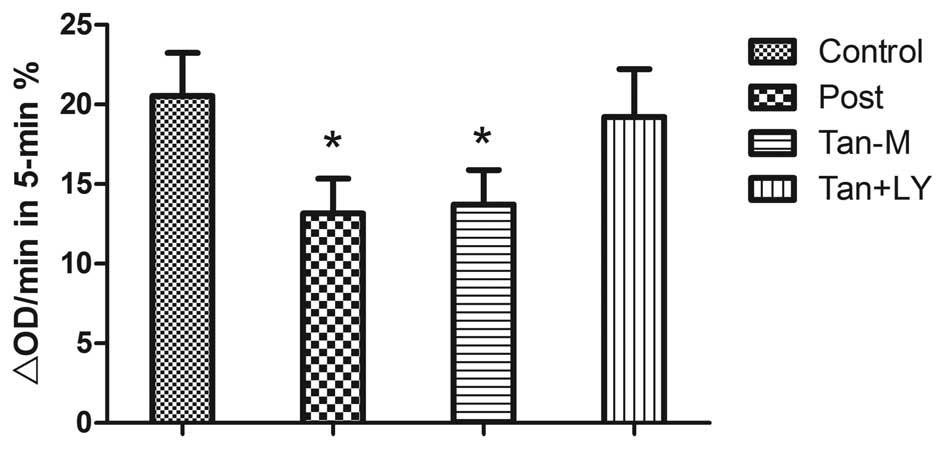|
1
|
Braunwald E and Kloner RA: Myocardial
reperfusion: a double-edged sword? J Clin Invest. 76:1713–1719.
1985. View Article : Google Scholar : PubMed/NCBI
|
|
2
|
Murry CE, Jennings RB and Reimer KA:
Preconditioning with ischemia: a delay of lethal cell injury in
ischemic myocardium. Circulation. 74:1124–1136. 1986. View Article : Google Scholar
|
|
3
|
Maulik N, Engelman RM, Wei Z, et al:
Interleukin-1 alpha preconditioning reduces myocardial ischemia
reperfusion injury. Circulation. 88:II387–II394. 1993.PubMed/NCBI
|
|
4
|
Zhao ZQ, Corvera JS, Halkos ME, et al:
Inhibition of myocardial injury by ischemic postconditioning during
reperfusion: comparison with ischemic preconditioning. Am J Physiol
Heart Circ Physiol. 285:H579–H588. 2003.PubMed/NCBI
|
|
5
|
Tissier R, Waintraub X, Couvreur N, et al:
Pharmacological postconditioning with the phytoestrogen genistein.
J Mol Cell Cardiol. 42:79–87. 2007. View Article : Google Scholar : PubMed/NCBI
|
|
6
|
Gao S, Liu Z, Li H, et al: Cardiovascular
actions and therapeutic potential of tanshinone IIA.
Atherosclerosis. 220:3–10. 2012. View Article : Google Scholar : PubMed/NCBI
|
|
7
|
Xu W, Yang J and Wu LM: Cardioprotective
effects of tanshinone IIA on myocardial ischemia injury in rats.
Pharmazie. 64:332–336. 2009.PubMed/NCBI
|
|
8
|
Tsang A, Hausenloy DJ, Mocanu MM and
Yellon DM: Postconditioning: a form of ‘modified reperfusion’
protects the myocardium by activating the phosphatidylinositol
3-kinase-Akt pathway. Circ Res. 95:230–232. 2004.
|
|
9
|
Lim SY, Davidson SM, Hausenloy DJ and
Yellon DM: Preconditioning and postconditioning: the essential role
of the mitochondrial permeability transition pore. Cardiovasc Res.
75:530–535. 2007. View Article : Google Scholar : PubMed/NCBI
|
|
10
|
Fang J, Chen L, Wu L and Li W:
Intra-cardiac remote ischemic post-conditioning attenuates
ischemia-reperfusion injury in rats. Scand Cardiovasc J.
43:386–394. 2009. View Article : Google Scholar : PubMed/NCBI
|
|
11
|
Fang J, Wu L and Chen L: Postconditioning
attenuates cardiocyte ultrastructure injury and apoptosis by
blocking mitochondrial permeability transition in rats. Acta
Cardiol. 63:377–387. 2008. View Article : Google Scholar
|
|
12
|
Wang G, Liem DA, Vondriska TM, et al:
Nitric oxide donors protect murine myocardium against infarction
via modulation of mitochondrial permeability transition. Am J
Physiol Heart Circ Physiol. 288:H1290–H1295. 2005. View Article : Google Scholar : PubMed/NCBI
|
|
13
|
Baines CP, Song CX, Zheng YT, et al:
Protein kinase Cepsilon interacts with and inhibits the
permeability transition pore in cardiac mitochondria. Circ Res.
92:873–880. 2003. View Article : Google Scholar : PubMed/NCBI
|
|
14
|
Hausenloy DJ and Yellon DM: New directions
for protecting the heart against ischaemia-reperfusion injury:
targeting the Reperfusion Injury Salvage Kinase (RISK)-pathway.
Cardiovasc Res. 61:448–460. 2004. View Article : Google Scholar : PubMed/NCBI
|
|
15
|
Yellon DM and Hausenloy DJ: Myocardial
reperfusion injury. N Engl J Med. 357:1121–1135. 2007. View Article : Google Scholar : PubMed/NCBI
|
|
16
|
Fu J, Huang H, Liu J, et al: Tanshinone
IIA protects cardiac myocytes against oxidative stress-triggered
damage and apoptosis. Eur J Pharmacol. 568:213–221. 2007.
View Article : Google Scholar : PubMed/NCBI
|
|
17
|
Tu EY, Zhou YG, Wang ZH, Liang QS and Yang
GT: Effects of tanshinone II A on the myocardial hypertrophy signal
transduction system protein kinase B in rats. Chin J Integr Med.
15:365–370. 2009. View Article : Google Scholar : PubMed/NCBI
|
|
18
|
Shan H, Li X, Pan Z, et al: Tanshinone IIA
protects against sudden cardiac death induced by lethal arrhythmias
via repression of microRNA-1. Br J Pharmacol. 158:1227–1235. 2009.
View Article : Google Scholar : PubMed/NCBI
|
|
19
|
Pan C, Lou L, Huo Y, et al: Salvianolic
acid B and tanshinone IIA attenuate myocardial ischemia injury in
mice by NO production through multiple pathways. Ther Adv
Cardiovasc Dis. 5:99–111. 2011. View Article : Google Scholar : PubMed/NCBI
|
|
20
|
Zhang Y, Wei L, Sun D, et al: Tanshinone
IIA pretreatment protects myocardium against ischaemia/reperfusion
injury through the phosphatidylinositol 3-kinase/Akt-dependent
pathway in diabetic rats. Diabetes Obes Metab. 12:316–322. 2010.
View Article : Google Scholar : PubMed/NCBI
|
|
21
|
Gao F, Gao E, Yue TL, et al: Nitric oxide
mediates the antiapoptotic effect of insulin in myocardial
ischemia-reperfusion: the roles of PI3-kinase, Akt, and endothelial
nitric oxide synthase phosphorylation. Circulation. 105:1497–1502.
2002. View Article : Google Scholar : PubMed/NCBI
|
|
22
|
Halestrap AP, Kerr PM, Javadov S and
Woodfield KY: Elucidating the molecular mechanism of the
permeability transition pore and its role in reperfusion injury of
the heart. Biochim Biophys Acta. 1366:79–94. 1998. View Article : Google Scholar : PubMed/NCBI
|
|
23
|
Bopassa JC, Ferrera R, Gateau-Roesch O,
Couture-Lepetit E and Ovize M: PI 3-kinase regulates the
mitochondrial transition pore in controlled reperfusion and
postconditioning. Cardiovasc Res. 69:178–185. 2006. View Article : Google Scholar : PubMed/NCBI
|
|
24
|
Argaud L, Gateau-Roesch O, Raisky O, et
al: Postconditioning inhibits mitochondrial permeability
transition. Circulation. 111:194–197. 2005. View Article : Google Scholar : PubMed/NCBI
|
|
25
|
Zhang SZ, Ye ZG, Xia Q, Zhang W and Bruce
I: Inhibition of mitochondrial permeability transition pore: A
possible mechanism for cardioprotection conferred by pretreatment
with tanshinone IIA. Conf Proc IEEE Eng Med Biol Soc. 3:2276–2279.
2005.PubMed/NCBI
|















